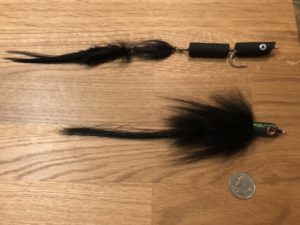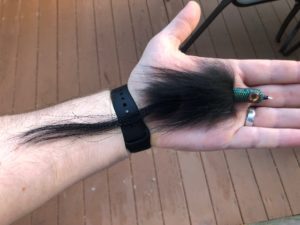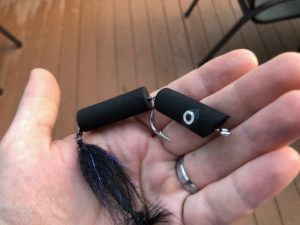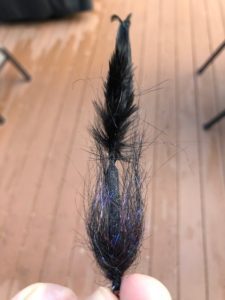Fly fishing at night for striped bass is a very different endeavor. So, it’s really important to step a bit outside of the norm when designing night patterns.

I want to share two proven patterns developed by Rich Murphy. If you fly fish for striped bass and don’t have Rich’s book, Fly Fishing for Striped Bass, you need to get it. It is the Bible of striped bass fishing for us long rodders.
The patterns I want to focus on are the RM Quarter Moon Special (top fly in photo on right) and the RM Rattlesnake (the bottom fly).
Rich emphasizes that for night flies you must incorporate the following characteristics:
- A long opaque silhouette when viewed from below (the Rattlesnake is nine-inches long and the Quarter Moon is 11-inches long)
- Neutral or floating buoyancy to ensure that the fly stays in the optimal visual window along the top 1/3 of the water column
- A front section that pushes water, creating a signal that bass can find with their lateral line
- Rattles to give sound signatures that draws stripers in from a distance (both flies have double rattles)
Both flies are surprisingly easy to cast on a standard nine-foot, nine-weight rod with a floating or intermediate head. Distances of 60′ to 70′ are possible. At night, I find 40′ to 50′ is usually all I need for casting distance.
I want to key in on some key characteristics of each fly and how to best fish them.
The tail assembly for the Rattlesnake is encased in medium and black EZ body tubing. It is tied free hand with two five-millimeter plastic rattles inside. It then is threaded onto a hook and secured at the beginning of hook bend. It gives a long silhouette and the EZ body portion will flex when the fly moves forward and when it falls.
Movement is limited in the EZ body section because herring and bunker typically only move the back half of their body when swimming. Because the tail is tied onto the hook shank, it is impossible to replace without ruining the fly. So, I use plastic rattles because Pyrex rattles are prone to breaking. As a result, this fly will last much longer, but I must caveat the noise quality of the plastic rattles is not as good as Pyrex.
The head has a 3/8″ EZ body with bucktail and Finnish raccoon to push water and have good movement when on the fall or pause. Rich calls for a spun deer hair head, but I the EZ body formed head instead because I admittedly hate spinning deer hair.

The RM Rattlesnake has a slow sink rate and is meant to be fished within one to three feet of the surface. It works well on open beaches and in estuaries.
It moves well on the swing, but it really shines when worked with series of moderate strips with a long pause.
Fish tend to crush it as soon as you initiate movement after the pause. If fishing an area with a lot of rocks, I don’t use the RM Rattlesnake and opt for a surface fly like the Quarter Moon Special or a pattern with a jig-style hook, as both hang up much less frequently.
The RM Quarter Moon Special is a floating, three-section, surface pattern. Because you are using wire and swivels instead of shanks, the motion of this fly is very different from a game-changer style fly.

The swivels allow equal freedom of movement up and down and side-to-side.
The front section has a 45° face to help it move along surface with a darting/sliding action while pushing a very nice surface wake.
The combined flotation of the middle and head sections keeps this fly on top, even in surface turbulence and the wash of the surf zone. On a slow strip retrieve, it has a very serpentine motion on the surface and resembles an eel’s movement pattern (stripers love eels!).
The tail has two four-millimeter Pyrex rattles in a small, black EZ Body and uses seven-inch saddle hackles to give a long tapered silhouette, just like an eel. The motion on the hackles is excellent if paused and on the swim.

I add a front collar of UV Craft fur to give the front section of the tail a wider profile and some subtle flash. A nice feature is that it is very easy to cutoff this tail section and replace it. This allows you to use Pyrex rattles with a much better sound quality to help get the fish looking up at the surface. Rich told me that he has found that foam sections are very durable, but you will need to replace the tail several times in the life of the fly.
Until finding Rich’s book, my primary night surface flies were poppers and gurglers, which do catch striper well at night. However, I think they are much better daytime flies, personally. Less noisy wakes for surface presentations seem to produce more and bigger fish for me than loud poppers.
This fly is the ideal answer to that need, and I am very thankful Rich was willing to share his best surface pattern in his book. My absolute favorite places to fish this fly are boulder fields by inlets or main beach points.
I have been developing my own custom night fly patterns, and if you want to check them out and the field testing reports this season, they are on my Instagram at @canalflyguy. If you want to put more and larger stripers on the beach, you should be fishing at night and using patterns designed to succeed at night.
You cannot go wrong with these two proven patterns from Rich Murphy. The only place where I don’t reach for these flies is when shallow water flats at night. Rich also has a great night-time shallow water fly patterns, but you will need to pick up his book to learn about that one!
Discover more from BlogFlyFish.com
Subscribe to get the latest posts to your email.

Those look pretty sweet. Never been night time striper fishing. Gonna have to try that out!
One of my favorite pastimes is fishing topwater on ponds for largemouth bass at night; this sounds like it would be even more heart pounding! Looking forward to your insta posts and hopefully getting out there!